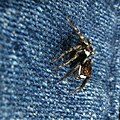Greenhouse jumping spider
| Greenhouse jumping spider | ||||||||||||
|---|---|---|---|---|---|---|---|---|---|---|---|---|

Greenhouse jumping spider ( Hansarius adansoni ), male |
||||||||||||
| Systematics | ||||||||||||
|
||||||||||||
| Scientific name | ||||||||||||
| Hasarius adansoni | ||||||||||||
| ( Audouin , 1826) |
The greenhouse jumping spider ( Hasarius adansoni ) is a web spider from the family of jumping spiders (Salticidae). It is not to be confused with the greenhouse spider , from the family of hooded web spiders (Theridiidae), which also occurs as a crop follower in greenhouses .
features
The body length of the greenhouse jumping spider is five to six millimeters in the males and six to seven millimeters in the females.
female
The basic color of the female is brown, with the front body ( prosoma ) red-brown and the rear body ( opisthosoma ) rust-brown. Between the eyes, the upper body of the female is black-brown. As with the male counterpart, there are also several bandages in the female. One of them is arched, yellow-gray and runs between the eyes. On the front edge of the abdomen in the female there is another yellow-gray band. Two wavy, curved black bands run along the left and right of the abdomen.
male
The basic color of the male is black. At the edge of the head is a circular white bandage, which turns into a brown bandage in the eye area. The male's buttons are black, while the tibia, patella and tip of the femur are densely hairy white. The male's abdomen is colored rust-brown at the top, and a white hair band can also be found on its edge. The males also have two wavy black longitudinal bands on the opisthosoma, in contrast to the females they show two conspicuous white dots at the rear end.
Color perception
Like all jumping spiders, the greenhouse jumping spider has eight eyes, two large and two medium-sized eyes pointing straight ahead. These enable the spider to visually perceive its prey. The two large main eyes arranged in the middle have large glass bodies that have a long focal length and whose focus can be changed. Four superimposed retinal levels allow different perception depending on the wavelength of the light. The lower and the overlying retina are sensitive to green. However, the green image is only shown in focus on the lowest level. The difference in sharpness between these two retinal layers enables distance assessment . A food animal can be targeted by the jumping spider at a distance of 10 to 20 centimeters and preyed on by jumping forward suddenly. The mechanism of distance perception through different focussing on retinal levels was explored for the first time in the greenhouse jumping spider.
Occurrence
The original home of the greenhouse spring spider is not known. It is believed that it originated in the tropics . The distinctive species is common in greenhouses around the world. In the warmer climates of Asia, for example in the Chinese provinces of Gansu , Guangxi , Guangzhou and Yunnan , on Taiwan and in Japan , it can also be found outdoors, often around the greenhouses of universities, botanical gardens and zoos. It is also found in Australia and on numerous islands off the coast of this continent. In Europe it seems to have seldom established itself outdoors. Only one specimen was found under a stone on the island of Gran Canaria . In Crete it is proven from rocky beaches.
Way of life
The greenhouse jumping spider does not build fishing nets like most other spiders. In addition, it lacks the third tarsal claw on each of its eight legs, which has been reduced in favor of thick hair on the end links of the tarsi. This jumping spider also finds a hold on smooth surfaces through adhesive forces and can often be found climbing on plants or walls where it was found. It also likes to hide under tree bark or tendrils of climbing plants in a woven sack. Since the animals are not influenced by the seasons due to their preferred habitat, they can be found there all year round.
The greenhouse jumping spider is diurnal and lurks for fruit flies or other small insects that occur in the greenhouses and their surroundings , which it targets precisely with its visual acuity and which it jumps surprisingly quickly and accurately thanks to the hydraulic bounce of its legs.
Systematics and taxonomy
The proximity to humans has made the greenhouse jumping spider a relatively well-researched jumping spider. The first description under the name Attus adansonii comes from Victor Audouin , who published the description of this and many other spiders following Napoleon's Egyptian campaign in 1826 after the specimens from Egypt . Up to 2012 this spider species was described 86 times in detail from other parts of the world and placed in other genera several times. The now recognized assignment to the genus Hasarius was made in 1871 by the French arachnologist Eugène Simon . Hasarius adansoni is the type species of the genus. The specific epithet adansoni honors the French naturalist Michel Adanson (1727–1806).
gallery
Individual evidence
- ↑ a b H. Eikamp & N. Schiller: Jumping spider Hasarius adansoni, also called "greenhouse spider". , NAOM leaflet, 033-14, March 2014
- ↑ a b Heiko Bellmann: The cosmos spider guide. Over 400 species in Europe. Kosmos Naturführer, Kosmos (Franckh-Kosmos), 1st edition, Stuttgart 2010, p. 216
- ↑ a b c Heiko Metzner: Hasarius adansoni , Worldwide database of jumping spiders (Arachnida, Araneae, Salticidae), 2015, accessed on March 7, 2010
- ↑ Takashi Nagata et al .: Depth perception from image defocus in a jumping spider. Science, Volume 335, No. 6067, pp. 469-471, January 27, 2012 doi : 10.1126 / science.1211667
- ^ Marie E. Herberstein & Darrel J. Kemp: A Clearer View from Fuzzy Images. Science, Volume 335, No. 6067, pp. 409-410, January 27, 2012 doi : 10.1126 / science.1216887
- ↑ Barbara Patoleta & Marek Żabka: Salticidae (Arachnida, Araneae) of Islands off Australia. The Journal of Arachnology, 27, pp. 229-235, 1999
- ↑ Hasarius adansoni in the wiki of the Spinnenforum, accessed on March 7, 2010
- ^ Victor Audouin: Explication sommaire des planches d'arachnides de l'Egypte et de la Syrie; publiée par Jules-César Savigny. In: Description de l'Egypte. Histoire Naturelle. 1, 4, pp. 99-186, 1826
- ↑ Hasarius adansoni (Audouin, 1826) , World Spider Catalog, Naturhistorisches Museum der Bürgergemeinde Bern, 2016, accessed on March 8, 2016
- ^ Eugène Simon: Révision des Attidae européens. Supplément à la monographie des Attides (Attidae Sund.). Annales de la Société Entomologique de France, 5, 1, pp. 125-230, 329-360, 1871
literature
- Heiko Bellmann : The cosmos spider guide. Over 400 species in Europe. Kosmos Naturführer, Kosmos (Franckh-Kosmos), 1st edition, Stuttgart 2010, p. 216 ISBN 978-3-440-10114-8
- Victor Audouin : Explication sommaire des planches d'arachnides de l'Egypte et de la Syrie; publiée par Jules-César Savigny. In: Description de l'Egypte. Histoire Naturelle. 1, 4, pp. 99–186, 1826 (first description)
Web links
- Greenhouse jumping spider in the World Spider Catalog
- Hasarius adansoni in the Wiki of the Spider Forum, accessed on March 7, 2010
- Elsa Youngsteadt: Spiders Hunt With 3-D Vision . Wired, Science, January 26, 2012, accessed March 1, 2016







